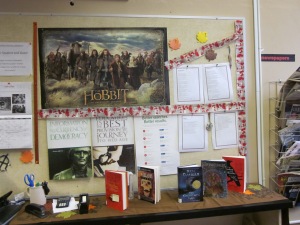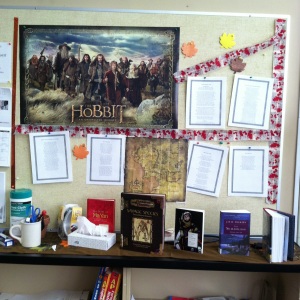Recently I had the odd experience of learning about something occurring in my own neighborhood from the online young adult world and then watching it play out online and in the local paper. I’m referring to the Cape Henlopen School District removing The Miseducation of Cameron Post from a summer reading list. A lot of great posts have been written about how misguided this choice was and I’ve found it inspiring to see how the YA community worked with the local community to get the book into the hands of kids who want it. Here I’m going to speak about the latest development a writing contest that gives teenagers a chance to say their thoughts about the book as well as provide a sense of the local context.
To start, the wonderful coda that is the essay contest. To quote the text of the flyer which is currently hanging over the new young adult books section at the Lewes Library.
The adults have had their say. Now it’s your turn. If you’re a high school student in Delaware, you’re invited to:
-
Get a free copy of The Miseducation of Cameron Post from Browseabout Books (student ID required)
-
Write a 250-500 word essay about what you think board members should know about the book before deciding whether it belongs on a school reading list
- Submit your essay to ncac@ncac.org by September 1st
I love the idea of this because one of my main complaints as I read through all of the articles that kept appearing in the Cape Gazette, the local paper, was how there weren’t enough student voices.
Now to get into a little explanation of where all of this happened since Sussex County, Delaware is currently in a great deal of economic and demographic flux. Sussex County and especially the area which Cape Henlopen serves is compromised of a number of different social groups and they don’t all fit together. Along the coast in towns like Lewes and Rehoboth Beach, retirees with liberal backgrounds from major cities such as Philadelphia, Washington DC and Baltimore have second homes and many live year round. Rehoboth Beach is known for being a welcoming place for the LGBTQ population.
A little further inland, farms and developments vie for land with places that conservationists have saved carving out their own spaces. According to the Sussex County Economic Development Office, the three main industries are manufacturing such as PATS Aircraft, Agriculture/Food Processing with the Mountaire Farms, mainly known for poultry the largest and then the three main hospitals; Beebe Medical Center, Bayhealth Medical Center and Nanticoke Health Services. Tourism and educational services also provide jobs through a University of Delaware Campus, Sussex Tech and a branch of Wilmington University. This means that the area can sometimes feel split between those who’ve been here for a while and tend to be more conservative and the newer and older residents that can be more liberal as well as immigrants that move here to work. A good explanation of how this looks politically comes from a write-up of Delaware around the 2012 elections from The New York Times:
“Almost all of Sussex County is rural. It is the top poultry producing county in the country. Along its coast, however, more than two decades of investment has cultivated a string of resorts, Mr. Pika said, and now liberal pockets can be found there. Rehoboth Beach, for example, has a substantial gay community.”
My family came down to this area to retire into one of those liberal pockets and they’re steadily making inroads into changing the political climate but it’s not easy to do.
All of this background is to show how in a place where same-sex couples are common a book can be banned for bad language with underlying homophobia. One aspect that I found fascinating was how little thought apparently went into choosing the list as it was apparently the first year it was done. It’s good that they trusted the Delaware Library Association to make intelligent choices, but the fact that most of the School Board and parents didn’t know much about these books wasn’t. Also none of this went through the normal process for challenging a book, which in the majority of libraries I’m familiar with requires the one challenging to read the book. All of the books were from the Blue Hen list which is selected by the Delaware Library Association, these books were then offered to incoming ninth graders to read. The way it all played out was strange too, the book was banned, then put back on the list and then the entire list was pulled. An interesting aspect was how a major part of rallying around the School Board came not from any thought on the book itself but more supporting the local government.
One letter that stood out for me was from someone who grew up in the area, was proud of not reading the book and fully backed the board; “I would like to commend the board on its decision to remove the above mentioned book from the summer reading list for incoming freshman. I hope that you are able to stand by that decision. I have not read the book.”
In a recent article from July 29th, a number of locals are quoted which gives a good sense of what happened.
“She’s promiscuous, drinks all the time and does drugs,” Hesson said. “Are we pulling students up, or are we just handing them stuff?”
While the Metcalfes and Hesson represented about half of 50 people who attended the meeting, just as many continued to support the book and the message it offers for gay students.
Recent Cape graduate Madison Bacon said gay kids are bullied in school, and “The Miseducation of Cameron Post” could help them handle adversity.
“It is a wonderful book. When I heard you removed it, it made me very sad,” she said.
Looking back over what happened, I think that the entire area has been surprised by how involved the outside world became in the book banning. I know that Browseabout Books is still giving books away as they’re provided for part of the contest and according to a librarian friend, Emily Danforth is going to give a Skype talk to a LGBTQ book group that meets at the library. The entire experience feels like its reflected a lot of the cultural conversations in the country as well as the power of connecting in as many avenues as possible.
I feel proud to be a librarian, a reader of young adult literature and someone who can add a few words to this conversation. For my own part, I read The Miseducation of Cameron Post at the end of 2012 and enjoyed it immensely.




